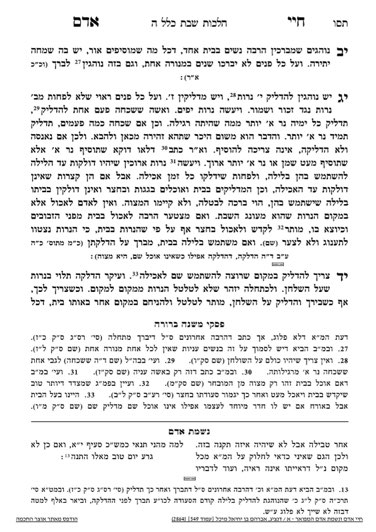We are beginning siman 12. The Chayei Adam writes that the minhag is for multiple women to light in the same place and make a bracha. We learned (S0131) that the Shulchan Aruch holds this is incorrect, and once one woman lights in a room, additional women who light do not make a bracha. The Rema writes that our minhag is that multiple women can make a bracha in the same place. The Chayei Adam follows the opinion of the Rema.
The Chayei Adam qualifies that even though he follows the minhag of the Rema, each woman should light their own separate leichter, and it should be clear that each is adding light to the room. When each woman adds light to the room, they are adding some benefit to the room by adding more happiness and oneg shabbos. If they light in the same leichter, the benefit is not recognizable.
Nevertheless, the Chayei Adam writes that the minhag is to permit multiple women lighting in the same leichter. The Mishnah Berurah explains that many women were too poor to afford their own leichter, so they had no choice but to share. Therefore, the halacha is that if multiple women are lighting at a simcha, or other situation, preferably they should light in a way that each person is clearly adding something to the room, but if not, they can still make a bracha.
In siman 13, the Chayei Adam writes that some people have a minhag to light 10 neiros, corresponding to the aseres hadibros. The Mishnah Berurah writes that this minhag does not require all 10 candles to be on the table, but they can be spread around the room. The Chayei Adam writes that some people have the minhag to light seven candles, corresponding to the seven days of the week. Preferably, a person should not light less than two candles, corresponding to zachor v’shamor.
There is one case in which the Shulchan Aruch writes that a person should light only one candle. If one did not make the proper preparations for hadlakas neiros before Yom Tov, they light only one candle. We learn from this case that the barest minimum is one candle, but preferably one should light two.
It is a hiddur mitzvah for both the neiros and for Shabbos to light beautiful neiros.
A woman who forgot to light one Shabbos is given a fine that she now has to light an additional candle for the rest of her life. This fine is both a financial burden, especially for someone fairly poor, and an embarrassment, especially when the minhag in the city is for everyone to light only two neiros. Nowadays, many women light an amount of neiros corresponding to the amount of children they have, so there is not necessarily an element of embarrassment. The purpose of this fine is to serve as a reminder for the future.
Given that this is a fine, if the woman was an oneiss, and was unable to light for a valid reason, she does not have to add a candle. The Elya Rabba writes that one can fulfill the fine by adding extra oil, or lighting a larger candle, each time she lights. We see that the point is not to make it obvious or embarrass her, but to remind her not to make a mistake in the future.
Summary
- Multiple women can light in the same room and make a bracha. Preferably, they should each light in a way that their neiros are distinct from other neiros, but if need be, they can even light in the same leichter.
- Lechatchilla, one should light two neiros. Some have the minhag to light seven or 10. The barest minimum is one ner.
- If a woman forgot to light one Shabbos, she is fined in that she must now light an additional candle for the rest of her life. The Elya Rabba holds that she does not have to light an entire additional candle, but adding to the size of her current candles is sufficient. If she was an oneiss, the fine does not apply.



